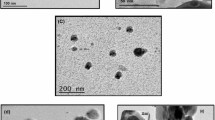Abstract
Fluorescence Resonance Energy Transfer (FRET) is a powerful tool to determine distances between chromophores bound to macromolecules, since the efficiency of the energy transfer from an initially excited donor to an acceptor strongly depends on the distance between the two dye molecules. The structure of the noncovalent complex of double-strand DNA (dsDNA) with thiazol orange dimers (TOTO) allows FRET analysis of two intercalated chromophores. By intercalation of two different TOTO dyes we observe an energy transfer from TOTO-1 as donor and TOTO-3 as acceptor. In this manner we are able to determine the mean distance between two proximate TOTO molecules bound to dsDNA. Thus the maximum number of binding positions for this type of intercalation dyes in the dsDNA can be obtained. Furthermore the dependency of the acceptor emission on the donor concentration is analysed. The emission of TOTO-3 reaches a maximum when the acceptor-to-donor ratio is 1:10.
Similar content being viewed by others
References
H. S. Rye, S. Yue, D. E. Wemmer, M. A. Quesada, R. P. Haugland, R. A. Mathies, and A. N. Glazer (1992). Stable fluorescent complexes of double-stranded DNA with bis-intercalating asymmetric cyanine dyes—Properties and applications. Nucleic Acids Res. 20(11), 2803-2812.
J. A. Bordelon, K. J. Feierabend, S. A. Siddiqui, L. L. Wright, and J. T. Petty (2002). Viscometry and atomic force microscopy studies of the interactions of a dimeric cyanine dye with DNA. J. Phys. Chem. B 106(18), 4838-4843.
A. N. Glazer and H. S. Rye (1992). Stable dye-DNA intercalation complexes as reagents for high-sensitivity fluorescence detection. Nature 359(6398), 859-861.
N. Milanovich, M. Suh, R. Jankowiak, G. J. Small, and J. M. Hayes (1996). Binding of TO-PRO-3 and TOTO-3 to DNA: Fluorescence and hole-burning studies. J. Phys. Chem.-Us 100(21), 9181-9186.
J. P. Jacobsen, J. B. Pedersen, L. F. Hansen, and D. E. Wemmer (1995). Site-selective bis-intercalation of a homodimeric thiazole orange-dye in DNA oligonucleotides. Nucleic Acids Res. 23(5), 753-760.
H. P. Spielmann, D. E. Wemmer, and J. P. Jacobsen (1995). Solution structure of a DNA complex with the fluorescent bis-intercalator TOTO determined by NMR-spectroscopy. Biochemistry.-Us 34(27), 8542-8553.
S. Laib, M. Rankl, T. Ruckstuhl, and S. Seeger (2003). Sizing of fluorescently stained DNA-fragments by surface scanning microscopy. Nucleic Acids Res. 31(22), e138.
P. M. Goodwin, W. P. Ambrose, H. Cai, W. K. Grace, E. J. Larson, B. L. Marrone, J. H. Jett, J. H. Werner, and R. A. Keller (2002). in J. J. Kasianowicz, M. S. Z. Kellermayer, and D. W. Deamer (Eds.), Structure and Dynamics of Confined Polymers, Kluwer Academic, Dordecht, The Netherlands, pp. 351-370.
R. M. Clegg (1996). in X. F. Wang and B. Herman (Eds.), Fluorescence Imaging Spectroscopy and Microscopy, Wiley, New York, pp. 179-252.
L. Stryer (1978). Fluorescence energy-transfer as a spectroscopic ruler. Annu. Rev. Biochem. 47, 819-846.
J. R. Lakowicz (1999). Principles of Flourescence Spectroscopy, 2nd ed. Kluwer Academic/Plenum, New York.
T. Förster (1968). in O. Sinanoglu (Ed.), Modern Quantum Chemistry, Academic Press, New York, p. 93.
T. Förster (1948). Zwischenmolekulare Energiewanderung und Fluoreszenz. Ann. Phys. 2, 55-75.
R. E. Harrington (1970). Flow birefringence of persistence length deoxyribonucleic acid—hydrodynamic properties, optical anisotropy, and hydration shell anisotropy. J. Am. Chem. Soc. 92(23), 6957-6964.
B. P. Maliwal, J. Kusba, and J. R. Lakowicz (1995). Fluorescence energy-transfer in one-dimension—frequency-domain fluorescence study of DNA-fluorophore complexes. Biopolymers 35(2), 245-255.
B. W. van der Meer (2002). Kappa-squared: From nuisance to new sense. Rev. Mol. Biotechnol. 82, 181-196.
J. M. Schins, A. Agronskaia, B. G. de Grooth, and J. Greve (1999). Orientation of the chromophore dipoles in the TOTO-DNA system. Cytometry 37(3), 230-237.
J. L. Mergny, A. S. Boutorine, T. Garestier, F. Belloc, M. Rougee, N. V. Bulychev, A. A. Koshkin, J. Bourson, A. V. Lebedev, B. Valeur, N. T. Thuong, and C. Helene (1994). Fluorescence energy-transfer as a probe for nucleic-acid structures and sequences. Nucleic Acids Res. 22(6), 920-928.
J. R. Lakowicz, G. Piszczek, and J. S. Kang (2001). On the possibility of long-wavelength long-lifetime high-quantum-yield luminophores. Anal. Biochem. 288(1), 62-75.
M. T. Record, C. F. Anderson, and T. M. Lohman (1978). Thermodynamic analysis of ion effects on binding and conformational equilibria of proteins and nucleic-acids—Roles of ion association or release, screening, and ion effects on water activity. Q. Rev. Biophys. 11(2), 103-178.
W. D. Wilson (1999). In E. T. Kool (Ed.), DNA and Aspects of Molecular Biology, Comprehensive Natural Products Chemistry. Pergamon, Amsterdam, pp. 427-476.
X. M. Yan, W. K. Grace, T. M. Yoshida, R. C. Habbersett, N. Velappan, J. H. Jett, R. A. Keller, and B. L. Marrone (1999). Characteristics of different nucleic acid staining dyes for DNA fragment sizing by flow cytometry. Anal. Chem. 71(24), 5470-5480.
D. M. Crothers (1968). Calculation of binding isotherms for heterogeneous polymers. Biopolymers 6(4), 575-580.
R. W. Armstrong, U. P. Strauss, and T. Kurucsev (1970). Interaction between acridine dyes and deoxyribonucleic acid. J. Am. Chem. Soc. 92(10), 3174-3180.
D. G. Xu and T. M. Nordlund (2000). Sequence dependence of energy transfer in DNA oligonucleotides. Biophys. J. 78(2), 1042-1058.
Author information
Authors and Affiliations
Corresponding author
Rights and permissions
About this article
Cite this article
Laib, S., Seeger, S. FRET Studies of the Interaction of Dimeric Cyanine Dyes with DNA. Journal of Fluorescence 14, 187–191 (2004). https://doi.org/10.1023/B:JOFL.0000016290.34070.ee
Issue Date:
DOI: https://doi.org/10.1023/B:JOFL.0000016290.34070.ee




